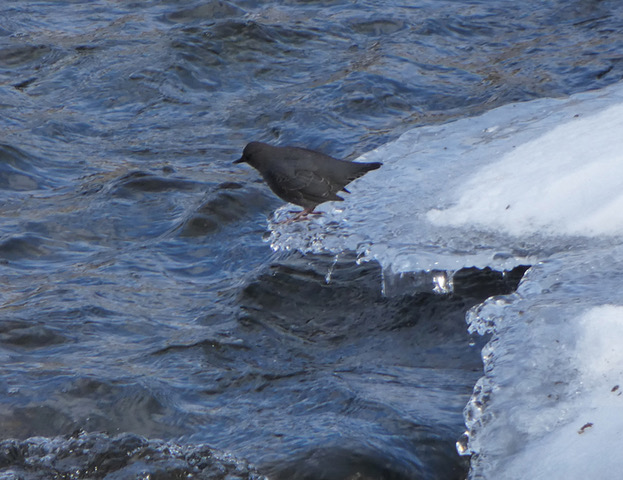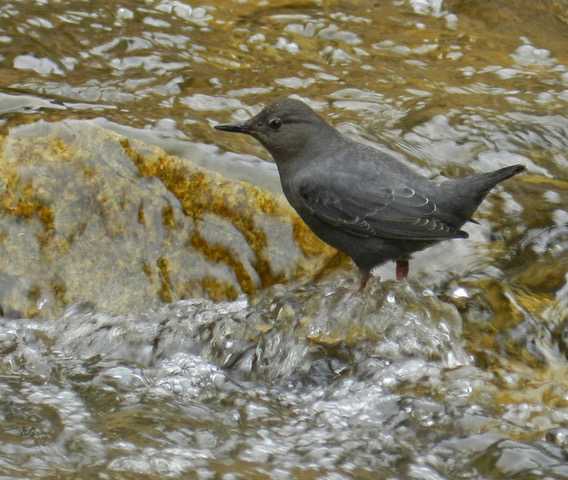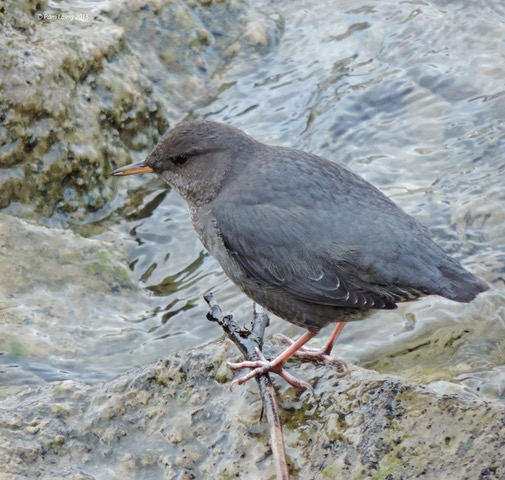You might suppose that wintertime is not a good time for a bird that spends its life near running water, but in fact this species is able to survive in icy cold water, and manages to feed even under riverside ice. The rather nondescript appearance of the American Dipper belies its amazing capabilities. And winter is when we have our best chance of seeing them, if we only know where to look.
The American Dipper is the most aquatic North American songbird, at home in the cold, rushing streams of western North America. In our valley you can often see them on the ice at the fringes of rivers or streams in winter, where their characteristic bobbing up and down, as if they are doing knee-bends, is rather endearing. These birds are only about 7.5” / ~19 cm in size, with a wingspan of 11” / ~28 cm. They are round in shape, a dark grey overall with sturdy pink legs and a straight black beak. If you look closely you can see that the head is a slightly browner colour.

They range from Alaska and the Yukon southwards through BC to California, Arizona, New Mexico and even into Central America. In our area they breed mainly in the mountains and foothills, only coming down to the valley bottom during the colder months. I often see them in winter on Mission Creek in Kelowna, and a pair has nested at Hardy Falls in Peachland for many years, sometimes right behind the falls themselves. The nest is domed with a side entrance, often under a bridge or behind a fall of water. Clutch size is usually 4 to 5 eggs and sometimes two broods are hatched in a season.
Proximity to rushing water is not something these birds fear. In fact they seek it out. I have seen three young chicks perched on riverside rocks within inches of a rushing spring torrent, apparently quite comfortable there. A good place to see them in winter or early spring is below the dam in Penticton or below the dam at Okanagan Falls, where you can hear them singing, if you are lucky. It’s a pleasing song, loud and full of warbles, whistles and trills, the better to be heard, I imagine, above the noise of the fast-flowing water.


The feeding technique of these birds is unique. They plunge into streams looking for insect larvae under stones or in the streambed. The main food is caddisfly larvae but they also take insects and sometimes eat small fish and fish eggs. Their third eyelid, called the nictating membrane, is transparent and appears whitish if you happen to see it when the bird is bobbing on land or on the ice. Its function is to protect the eye when the bird is underwater.
You might expect that these small birds would be swept away downstream by the force of the current, but they seem able to hold their own, almost ‘flying under water’ as someone once described it to me, in order to catch edible matter in the water. When they do fly, they zigzag low over the water, turning with rapid wing beats as the stream changes course. Favourite perches are often easy to spot, splashed with ‘whitewash’ from the bird as it watches the water for prey.
So don’t dismiss a small grey bird without a second look when you are walking beside a stream or river in winter. And if it’s bobbing and staring intently at the water, wait for it to plunge head-first into the chilly stream, and emerge with something tasty to eat. It’s quite exciting to witness.

Pam Laing
Okanagan birder







Lynne Blake
Great education, thanks.
Brent Pickerill
Thank you for teaching me something new today. We saw an American Dipper in Penticton Creek today. Very interesting, very specialized little water bird. You can teach an old dog a new trick.
Lynn Calvert
Always look forward to reading your birding posts. Thanks.
Jennifer Corvec
I found this wonderful site while I was searching for information about dippers. I had seen a few of these little birds feeding and swimming in streams on a beautiful video about winter and nature in British Columbia this morning. I find dippers fascinating and never have seen any because I’m in Atlantic Canada in NB. This article was the first result that came up in my list when I searched for “Dippers in Canada”!
The video was on Youtube’s “4K Relaxation Channel” and titled “4K Winter Beauty of Canadian Nature”…dippers are at 28min and 39 min)